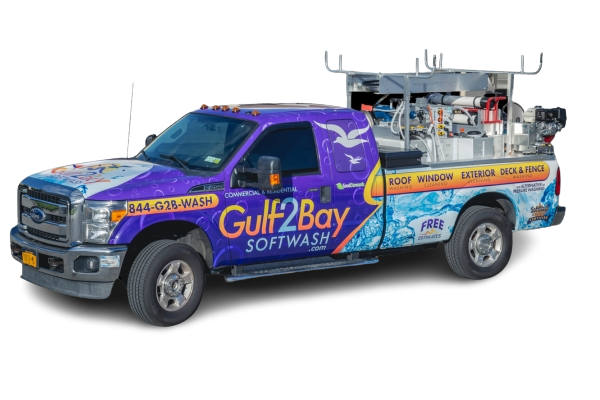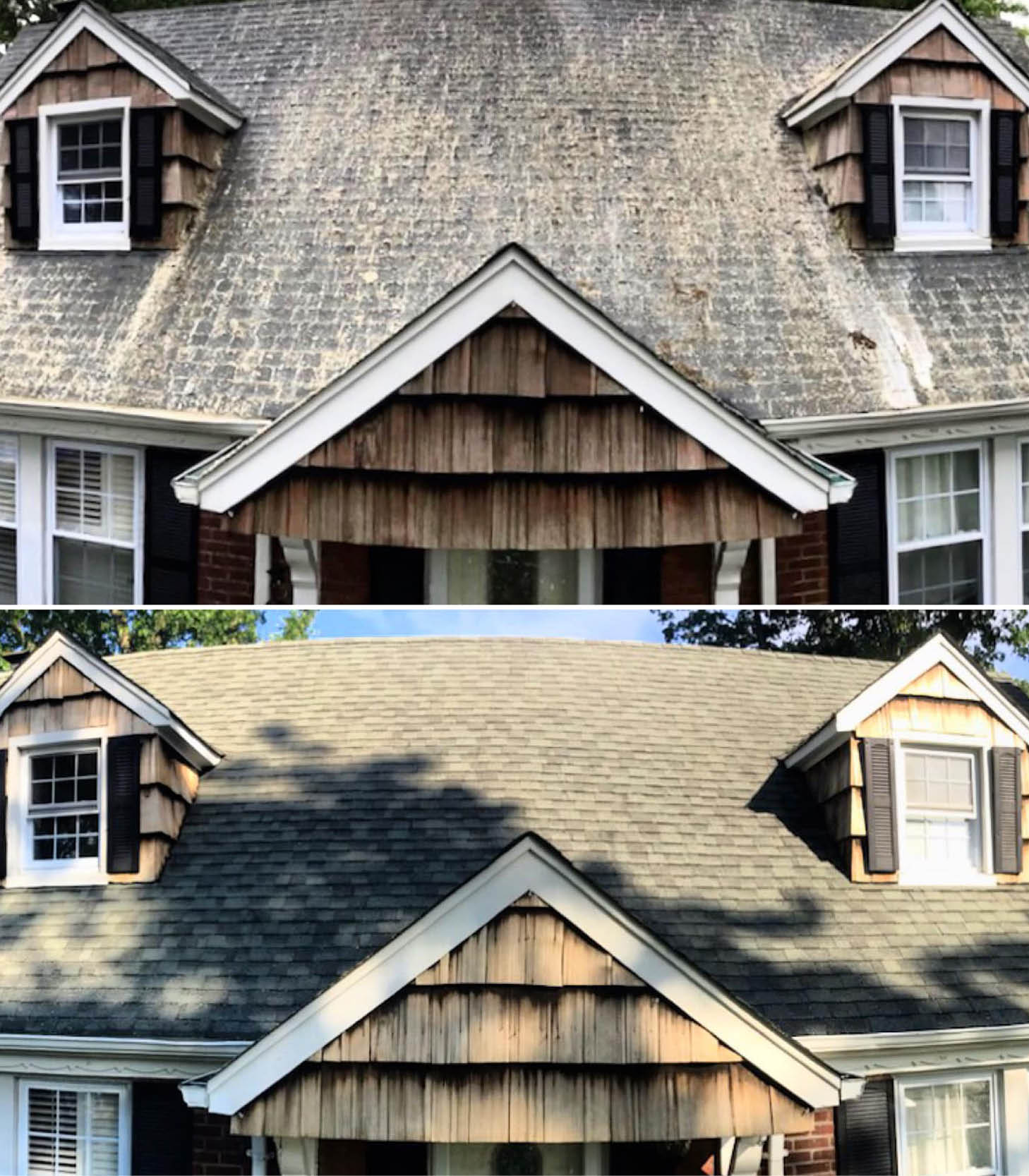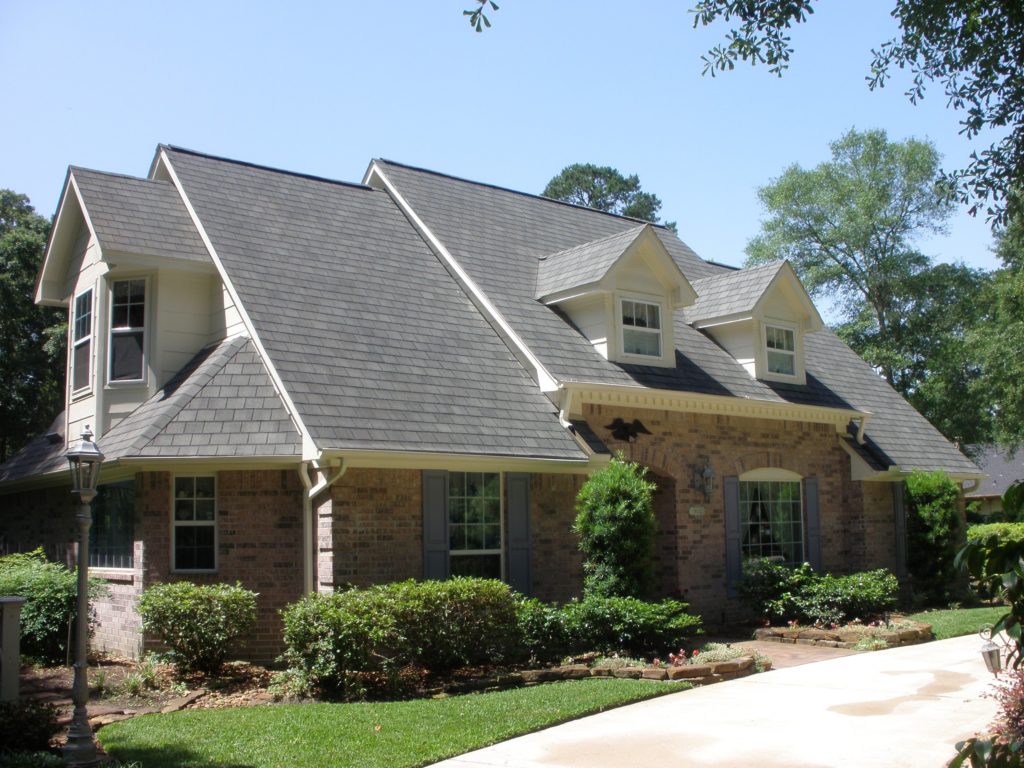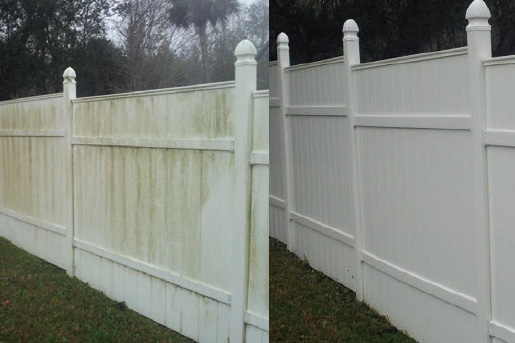
Do you have a healthy roof?
According to the International Association of Certified Home Inspectors (NACHI), a standard roof should last at least 20 years. Asphalt shingles, the primary material used here in the northeast, can now include warranties of up to 40, 50 or even 60 years.
However, your roof’s life expectancy is also contingent on the prevention of harmful bacteria from festering on its surface. When you notice the shingles start to discolor, a collection of debris, or pockets of moss or lichen growth on your roof, then it is time for soft washing assessment.
Getting your roof professionally washed and maintained will help extend the life of the shingles or other roof material.



Helps Prevent Costly Repairs
Falling debris, ice dams, moss, algae, and lichen growth can lead to long-term damage to your shingles. A thorough roof cleaning can help minimize or eliminate the damage caused by these affects.

Energy Efficiency
Removing the dark heat-absorbing stains and algae on your shingles will help the roof retain less heat, decreasing the amount of energy required to cool your home in the warmer months.

Keep Your Family Safe
Moss and algae left unattended on your shingles can infiltrate your roof underlayment and cause irreparable damage. When the wood begins to rot, moisture can enter the home creating a suitable environment for mold growth and water damage.
ROOF EVALUATION
When we send a specialist to evaluate your roof, there are certain factors they need look out for before we can schedule your service.
If there’s discoloration or organic growth on the surface, we can generally treat and restore its appearance with a deep clean using our soft wash system.
However, if bacteria and moss has been left to fester on the surface for too long, there may be granule loss and other signs of damage to the structural integrity of the roof. These issues would be indicated on your initial evaluation.
We recommend getting a roof assessment every 3-5 years to ensure a healthy roof.


Your Roof Assessment
Before we can schedule a soft wash we need to make sure there is no extensive damage to the roof material and structure.
Granule Loss and Shingle Deterioration
First, we check for the presence of shingle cupping, curling or granule loss. These issues may be associated with age or weather, but are sometimes caused by the growth of organisms such as algae, moss, mildew or mold.
Another contributing factor to shingle damage could be the use of improper power washing. The force of water from traditional pressure or power washing can do substantial harm to the shingles. This makes them more prone to blow off in their weakened state.
What’s worse is if moisture has taken hold on your roof from moss and debris buildup. Loose shingles will allow water to leak through to the underlayment and could lead to structural damage. The wooden roof deck will begin to rot and decay from the moisture over time, leading to costly repairs and replacements.
Roof cleaning requires a specialized soft washing technique. Not only does this method prevent damage by applying lower water pressure, it treats the mold and bacteria on the surface with a strong, biodegradable cleaning solution. This provides a deeper, safer clean to your roof.
Do You Know What's Eating Your Roof?
It’s important for us to understand the different stages of growth and bacteria in order to treat them effectively.

1. Debris buildup
Overhanging branches introduce leaves, sticks and other debris that allows for the retention of moisture. This damp environment becomes a breeding ground for bacteria growth.
Causes: Gloeocapsa magma thrives in the shade, often caused by the “canopy effect” which is when trees begin encroaching over the house, blocking direct sunlight. This prevents the shingles from drying out properly after rain or snowfall, creating a moist environment for bacteria to grow.
Wind and animals can spread the bacteria, growing from a dot to a streak over time. The particles can be air-borne, which can cause the bacteria to travel from one roof to another. It’s not unusual to see these stains occur on multiple houses in the same neighborhood due to the close proximity.
Impact: Dark stains, streaks and overall discoloration of the roof’s surface will occur. If left untreated it spreads to the entire surface of the roof, while the stains begin to darken and become more noticeable.
The composition of certain roof shingles and their propensity for trapping heat and moisture makes them an ideal environment for the bacteria to live and reproduce.
Gloeocapsa magma is not only unsightly, but over time can lead to premature aging of your roof and deterioration of the shingles. This may result in shingle rot or blow-off and costly roof repairs.
Algae particles give off airborne toxins that may be harmful when inhaled and have negative health effects, especially for individuals prone to allergy flare-ups.

2. Dark Streaks or Stains
The root cause for this occurrence is a blue-green algae called gloeocapsa magma, a form of cyanobacteria that typically thrives in warm and humid climates. They feed off of the granules of the shingles.

3. Green Moss
If you start to notice patches of green, fuzzy matter growing on your shingles, then you likely have a moss problem. Unlike blue-green algae, moss is a plant and can do serious damage to your shingles.
Causes: Similar to organic bacteria, moss thrives in shaded, damp environments. Moss is a non-vascular plant that absorbs water through its leaves instead of roots. Its seeds or spores, become air-borne and can spread rapidly. Once the spores attach to the roof, they gather in the space between the shingles and grow into a thick spongy moss.
Impact: The danger of moss lies in its ability to retain moisture. When water settles on a clean roof, it can air dry without lingering for too long. When moss grows abundantly, it acts as a heavy blanket on top of your roof that holds the water in place. As it grows thicker, it lifts and loosens the shingles, allowing water to leak through. This extra moisture can lead to mold, rot, and eventually, the decay of the roof’s framing.
Lichen is not a plant. It occurs as the result of a symbiotic relationship between algae or cyanobacteria (Gloeocapsa magma) and fungi (often caused by organic matter and fallen debris).
Causes: Where plant organisms like moss takes its energy from sunlight, lichen uses algae as its food source. It generally develops on roofs are prone to Gloeocapsa magma growth.
Impact: Lichen grows slowly but the longer its left to fester, the more invasive it becomes. Like moss, it can strip away protective oils on shingles, making them vulnerable to sun damage and erosion. The longer it’s left untreated, the more likely it is to cause permanent damage and stains on your roof.

4. Lichen
SOFT WASHING: THE SAFE ALTERNATIVE TO PRESSURE WASHING

When it comes to moss, for example, we perform a pre-rinse to remove the patches that are not deeply anchored. Moss is not a traditional rooted structure, instead it has thin root-like growths called rhizoids that will actually afix itself to the asphalt shingle. Our proprietary soft wash cleaning solution breaks down the moss and its rhizoids, killing the plant and preventing the spores from spreading any further. All of that moss will eventually fall off, but sometimes there is stubborn moss pieces left behind after applying the rinse. You don’t want to force it off because this could create micro-tearing inside the shingle which can compromise the material and shorten its lifespan.
We always strive for a hundred percent kill ratio. Our goal is for this leftover moss to change color from green to either white or opaque, meaning that it is completely dead and will eventually fall off naturally after a few heavy rains.
Soft washing is the only proven method to not only eradicate the growth on the surface, but prevents the return of bacteria to take hold. That's why we offer a 5 year warranty on all of our roof cleanings!
Pressure Washing
Pressure washing uses highly pressurized water to forcefully remove any dirt or grime from the surface that it comes into contact with. Since it only blasts away the dirt at the surface, without treating the root of the problem, it may result in the quicker return of this bacteria. Pressure washing also creates erosion and strips away materials that may have been loosened up by decomposition or aging, causing potential damage.
Soft Washing
The term soft washing refers to the application of water at no more than 90 PSI (this is comparable to your garden hose with a spray nozzle attached). At this PSI you will avoid granular loss. We also utilize different soap solutions, surfactants and detergents to effectively neutralize whatever we’re treating. The severity and type of growth helps us understand the percentage we need of each of those solutions.
Our trucks are equipped with soft wash proportioners, which allows us to draw specific percentages of our cleaning solutions. These custom mixtures, based on our bacterial assessment of the surface, are meant to effectively neutralize and kill whatever we’re treating.
We utilize antimicrobial soap (used as a preventative measure for organic growth) along with a surfactant, which makes the compound stick to the shingle. Also used is sodium hypochlorite, which acts as an emulsifier to disinfect any growth (organic or inorganic), in conjunction with water.

We safely and effectively clean all types of roofs.


- Asphalt Shingles
- Cedar
- Stone-Coated Steel
- Metal Roofing
- EPDM Flat Roofing
- Solar Tiles
- Wood Shake
- Aluminum Roofing
- Rubber Slate
- Slate Tiles
- Clay Tiles
- Concrete Tiles











